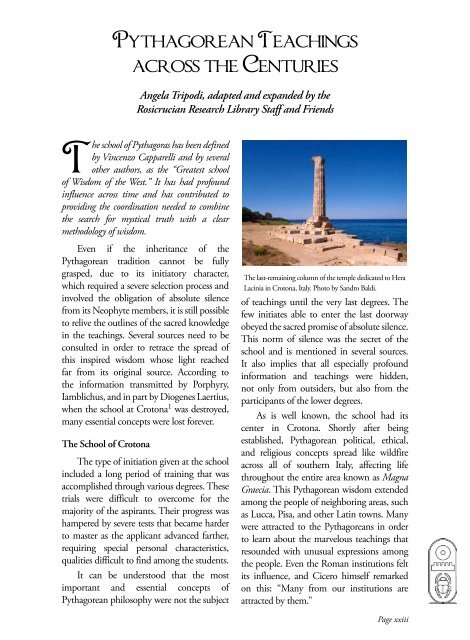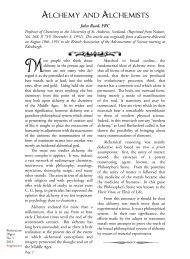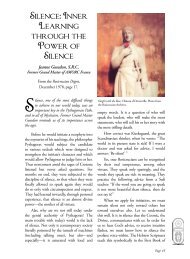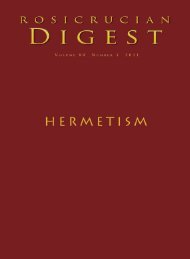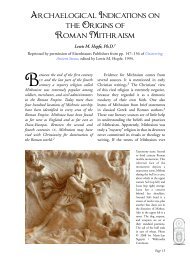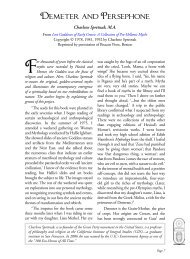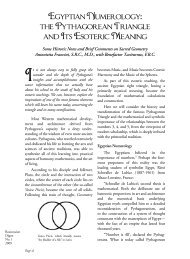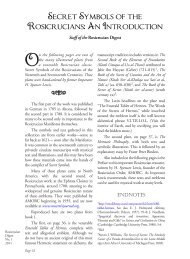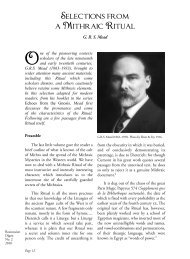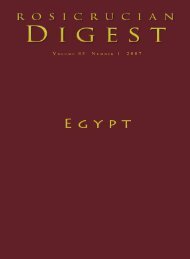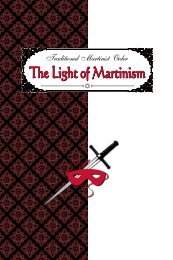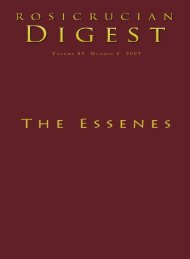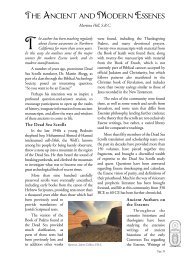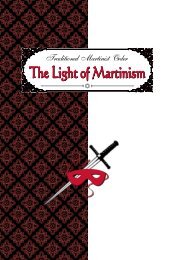Pythagorean Teachings across the Centuries - Rosicrucian Order
Pythagorean Teachings across the Centuries - Rosicrucian Order
Pythagorean Teachings across the Centuries - Rosicrucian Order
You also want an ePaper? Increase the reach of your titles
YUMPU automatically turns print PDFs into web optimized ePapers that Google loves.
<strong>Pythagorean</strong> <strong>Teachings</strong><br />
<strong>across</strong> <strong>the</strong> <strong>Centuries</strong><br />
Angela Tripodi, adapted and expanded by <strong>the</strong><br />
<strong>Rosicrucian</strong> Research Library Staff and Friends<br />
The school of Pythagoras has been defined<br />
by Vincenzo Capparelli and by several<br />
o<strong>the</strong>r authors, as <strong>the</strong> “Greatest school<br />
of Wisdom of <strong>the</strong> West.” It has had profound<br />
influence <strong>across</strong> time and has contributed to<br />
providing <strong>the</strong> coordination needed to combine<br />
<strong>the</strong> search for mystical truth with a clear<br />
methodology of wisdom.<br />
Even if <strong>the</strong> inheritance of <strong>the</strong><br />
<strong>Pythagorean</strong> tradition cannot be fully<br />
grasped, due to its initiatory character,<br />
which required a severe selection process and<br />
involved <strong>the</strong> obligation of absolute silence<br />
from its Neophyte members, it is still possible<br />
to relive <strong>the</strong> outlines of <strong>the</strong> sacred knowledge<br />
in <strong>the</strong> teachings. Several sources need to be<br />
consulted in order to retrace <strong>the</strong> spread of<br />
this inspired wisdom whose light reached<br />
far from its original source. According to<br />
<strong>the</strong> information transmitted by Porphyry,<br />
Iamblichus, and in part by Diogenes Laertius,<br />
when <strong>the</strong> school at Crotona 1 was destroyed,<br />
many essential concepts were lost forever.<br />
The School of Crotona<br />
The type of initiation given at <strong>the</strong> school<br />
included a long period of training that was<br />
accomplished through various degrees. These<br />
trials were difficult to overcome for <strong>the</strong><br />
majority of <strong>the</strong> aspirants. Their progress was<br />
hampered by severe tests that became harder<br />
to master as <strong>the</strong> applicant advanced far<strong>the</strong>r,<br />
requiring special personal characteristics,<br />
qualities difficult to find among <strong>the</strong> students.<br />
It can be understood that <strong>the</strong> most<br />
important and essential concepts of<br />
<strong>Pythagorean</strong> philosophy were not <strong>the</strong> subject<br />
The last-remaining column of <strong>the</strong> temple dedicated to Hera<br />
Lacinia in Crotona, Italy. Photo by Sandro Baldi.<br />
of teachings until <strong>the</strong> very last degrees. The<br />
few initiates able to enter <strong>the</strong> last doorway<br />
obeyed <strong>the</strong> sacred promise of absolute silence.<br />
This norm of silence was <strong>the</strong> secret of <strong>the</strong><br />
school and is mentioned in several sources.<br />
It also implies that all especially profound<br />
information and teachings were hidden,<br />
not only from outsiders, but also from <strong>the</strong><br />
participants of <strong>the</strong> lower degrees.<br />
As is well known, <strong>the</strong> school had its<br />
center in Crotona. Shortly after being<br />
established, <strong>Pythagorean</strong> political, ethical,<br />
and religious concepts spread like wildfire<br />
<strong>across</strong> all of sou<strong>the</strong>rn Italy, affecting life<br />
throughout <strong>the</strong> entire area known as Magna<br />
Graecia. This <strong>Pythagorean</strong> wisdom extended<br />
among <strong>the</strong> people of neighboring areas, such<br />
as Lucca, Pisa, and o<strong>the</strong>r Latin towns. Many<br />
were attracted to <strong>the</strong> <strong>Pythagorean</strong>s in order<br />
to learn about <strong>the</strong> marvelous teachings that<br />
resounded with unusual expressions among<br />
<strong>the</strong> people. Even <strong>the</strong> Roman institutions felt<br />
its influence, and Cicero himself remarked<br />
on this: “Many from our institutions are<br />
attracted by <strong>the</strong>m.”<br />
Page xxiii
Portrait of Socrates. Roman marble, first century CE,<br />
perhaps a copy of a lost bronze statue made by Lysippos.<br />
Louvre, Paris. Photo ©2005 Eric Gaba/Wikimedia<br />
Commons.<br />
<strong>the</strong> universe and all <strong>the</strong> individual objects.<br />
Next, Plato, in his Dialogues, Theaetetus,<br />
Parmenides, etc., demonstrates <strong>the</strong> influence<br />
of <strong>the</strong> <strong>Pythagorean</strong> school, so much so, as<br />
Burnet states, that Plato established his own<br />
academy with <strong>the</strong> intention of continuing <strong>the</strong><br />
line of teachings of <strong>the</strong> <strong>Pythagorean</strong> school. 3<br />
Moved by <strong>the</strong> desire for learning <strong>the</strong><br />
secrets of this “initiatic knowledge,” Plato was<br />
not satisfied to listen to <strong>the</strong> last representatives<br />
of <strong>Pythagorean</strong>ism, who had taken refuge in<br />
Greece (some of <strong>the</strong>se, as noted before, were<br />
part of <strong>the</strong> group surrounding Socrates).<br />
Ra<strong>the</strong>r, he tried to get in touch with those<br />
more advanced on <strong>the</strong> initiatic path. From<br />
this desire arose his need, according to some<br />
authors, to investigate more deeply and more<br />
personally in those places that had been <strong>the</strong><br />
<strong>the</strong>ater of <strong>the</strong> “<strong>Pythagorean</strong> drama.”<br />
In such places <strong>the</strong> environment had<br />
preserved traces of <strong>the</strong> events and still kept<br />
<strong>Rosicrucian</strong><br />
Digest<br />
No. 1<br />
2009<br />
Given <strong>the</strong>se beginnings, though this<br />
school had been founded by Greeks, it was<br />
intended to attract <strong>the</strong> interest of Italian<br />
Peninsular peoples more than all <strong>the</strong> o<strong>the</strong>r<br />
ancient schools; however, <strong>the</strong> contrary<br />
happened in many ways. Capparelli notes<br />
that in Italy <strong>the</strong> school of Pythagoras has had a<br />
negative reputation, at least in modern times. 2<br />
Several of <strong>the</strong> <strong>Pythagorean</strong> teachings have<br />
been attributed to o<strong>the</strong>r ancient philosophers<br />
such as Plato and Aristotle. Some literary<br />
critics, and among <strong>the</strong>m, Burnet, give <strong>the</strong><br />
following explanation.<br />
<strong>Pythagorean</strong> Influence on<br />
Socrates and Plato<br />
The <strong>Pythagorean</strong>s, after being dispersed,<br />
went to Greece and regrouped around<br />
Socrates, who became <strong>the</strong>ir leader and<br />
incorporated <strong>the</strong> original teachings with <strong>the</strong><br />
following modification: <strong>the</strong> <strong>Pythagorean</strong>s<br />
assumed <strong>the</strong> “universal” to be separated from<br />
<strong>the</strong> sensible objects. Socrates denied such<br />
separation and established <strong>the</strong> harmony of<br />
Page xxiv<br />
Alexander Visits <strong>the</strong> Sage Plato. Page from a dispersed<br />
manuscript of <strong>the</strong> Khamsa (Quintet) of Amir Khusrau<br />
Dihlavi. Mughal miniature attributed to Basawan, Lahore,<br />
1597/87. New York, Metropolitan Museum of Art.
alive <strong>the</strong> voice of <strong>the</strong> Master. In addition,<br />
it was possible to listen to <strong>the</strong> many stories<br />
in which <strong>the</strong> pain of <strong>the</strong> destruction of<br />
<strong>the</strong> school was still fresh. Also in such<br />
surroundings, memories were preserved<br />
with great care in certain families and could<br />
suggest to <strong>the</strong> sensitive mind of Plato <strong>the</strong><br />
correct materials for a reconstruction of a<br />
true and most genuine <strong>Pythagorean</strong>ism.<br />
According to Gomperz, Plato made<br />
use of this information to construct a link<br />
between <strong>the</strong> Socratic and <strong>the</strong> <strong>Pythagorean</strong><br />
teachings. Never<strong>the</strong>less, Plato, following <strong>the</strong><br />
tradition of silence, at <strong>the</strong> beginning rarely<br />
mentions <strong>the</strong> <strong>Pythagorean</strong>s. After his first<br />
trip to Italy, unavoidably and progressively<br />
he is more and more attracted to <strong>the</strong> voice<br />
of <strong>the</strong> “<strong>Pythagorean</strong> Siren,” so much so that,<br />
beginning with Meno, in his later dialogues<br />
and in <strong>the</strong> teachings of his immediate<br />
successors, we can witness <strong>the</strong> “inclusion of<br />
Platonism into <strong>the</strong> greater <strong>Pythagorean</strong>ism.”<br />
This change is also notable in Phaedo.<br />
In this work, Plato introduces Cebes and<br />
Simmias, <strong>Pythagorean</strong>s from Thebes, as<br />
those who listen to <strong>the</strong> last words of <strong>the</strong><br />
dying Socrates, and talk with him about<br />
immortality. This choice is relevant, as Plato<br />
did not place some Sophists or followers of<br />
Heraclitus or Anaxagoras at <strong>the</strong> scene; ra<strong>the</strong>r<br />
he chooses <strong>Pythagorean</strong>s. 4<br />
<strong>Pythagorean</strong> Elements in Aristotle’s Work<br />
Aristotle himself felt <strong>the</strong> influence of<br />
<strong>the</strong> <strong>Pythagorean</strong> doctrine, not only because<br />
he attended <strong>the</strong> Academy for twenty years,<br />
but also because he took part in <strong>the</strong> interesting<br />
meetings of <strong>Pythagorean</strong> savants. His<br />
early work, On Philosophy, discusses <strong>the</strong><br />
teachings of <strong>the</strong> <strong>Pythagorean</strong>s and Plato; and<br />
similarly, he does so in Eudemus (or “On <strong>the</strong><br />
Soul”), and Protrepticus, of which we only<br />
have short passages.<br />
According to Vincenzo Capparelli,<br />
Aristotle was one of <strong>the</strong> greatest students of<br />
Bust of Aristotle. Marble, Roman copy after a Greek bronze<br />
original by Lysippos from 330 BCE. The alabaster mantle<br />
is a modern addition. Palazzo Altaemps, Roma. Photo<br />
©2006 by Marie-Lan Nguyen/Wikimedia Commons.<br />
<strong>Pythagorean</strong> doctrine, “Not only because<br />
of <strong>the</strong> many years spent at <strong>the</strong> Academy,<br />
where he had <strong>the</strong> opportunity of learning<br />
all that was known <strong>the</strong>re. This information<br />
was <strong>the</strong> result of <strong>the</strong> long researches made by<br />
Plato himself, and because of <strong>the</strong> systematic<br />
historic research that he himself did (or was<br />
done by his students), Aristotle was able to<br />
have a rich and vast library.”<br />
In his Metaphysics, Aristotle wrote,<br />
“With respect to <strong>the</strong> activity of <strong>the</strong>se<br />
philosophers called <strong>Pythagorean</strong>, <strong>the</strong>y<br />
began <strong>the</strong> study of ma<strong>the</strong>matics and were<br />
<strong>the</strong> first to make progress in it. They grew<br />
accustomed to it to <strong>the</strong> point of believing<br />
that its principles were <strong>the</strong> principles of all<br />
entities. Given that numbers are <strong>the</strong> first<br />
elements of ma<strong>the</strong>matics, <strong>the</strong>y perceived in<br />
numbers much similarity with what exists<br />
and becomes.<br />
“Therefore, <strong>the</strong>y assumed that some<br />
aspect of numbers relates to justice, some<br />
o<strong>the</strong>r to soul and intellect, ano<strong>the</strong>r is <strong>the</strong><br />
‘right moment.’ Besides, <strong>the</strong>y found that <strong>the</strong><br />
Page xxv
elationships of harmony consist of numbers,<br />
and that all reality would be similar to<br />
numbers.... So <strong>the</strong>y arrived at <strong>the</strong> conclusion<br />
that <strong>the</strong> elements of number were <strong>the</strong> elements<br />
of all things, of all that exists on earth and<br />
that ‘heaven was harmony and numbers.’”<br />
In ano<strong>the</strong>r part of <strong>the</strong> same work,<br />
he added: “The <strong>Pythagorean</strong>s say that<br />
<strong>the</strong> principles are ten, expressed in pairs<br />
of opposites: limit-unlimited; even-odd;<br />
one-many; right-left; male-female; stillnessmovement;<br />
straight-bent; light-darkness;<br />
good-bad; square-rectangle.” 5<br />
The Tradition Returns to Egypt<br />
The Crotona School itself never rose<br />
from <strong>the</strong> ashes of destruction; however its<br />
influence spread with time more and more<br />
in <strong>the</strong> form of mysteries, of mysticism,<br />
almost of divination. So much so that<br />
<strong>Pythagorean</strong> thought found more fertile<br />
ground in Alexandria than in A<strong>the</strong>ns. There,<br />
<strong>the</strong> Western world had come more closely<br />
in contact with <strong>the</strong> Eastern world and<br />
was better able to understand <strong>the</strong> various<br />
Given that numbers are <strong>the</strong><br />
first elements of ma<strong>the</strong>matics,<br />
<strong>the</strong>y perceived in numbers<br />
much similarity with what<br />
exists and becomes.<br />
elements of Pythagoras’s wisdom. This<br />
understanding primarily lay in <strong>the</strong> realization<br />
that <strong>the</strong> essential teachings did not refer only<br />
to science, but involved a new concept of<br />
human destiny: <strong>the</strong> strong aspiration for a<br />
natural renewal.<br />
<strong>Pythagorean</strong> mysticism spread<br />
in two directions in <strong>the</strong> vast cultural<br />
environment of Alexandria: <strong>the</strong> Jewish-<br />
Alexandrian <strong>Pythagorean</strong>s and <strong>the</strong> Roman<br />
<strong>Pythagorean</strong>s. The latter is better known in<br />
our philosophical tradition <strong>the</strong>n <strong>the</strong> former.<br />
However, much of <strong>the</strong> content of <strong>the</strong><br />
<strong>Pythagorean</strong>ism of <strong>the</strong> Jewish community in<br />
Alexandria found a strong resonance in <strong>the</strong><br />
religious and moral continuity that gave rise<br />
to Christianity in Egypt.<br />
It is not easy to fix <strong>the</strong> date when <strong>the</strong><br />
revived <strong>Pythagorean</strong> movement established<br />
itself in Rome. Never<strong>the</strong>less, we must<br />
consider that those with austere ways who<br />
established <strong>the</strong> greatness of <strong>the</strong> Roman<br />
Republic would feel kinship with <strong>the</strong><br />
<strong>Pythagorean</strong> elevated morality and severe<br />
discipline. Probably from this circumstance<br />
arose <strong>the</strong> legend of Numa as being a disciple<br />
of Pythagoras, <strong>the</strong> elaboration of <strong>the</strong> Sibylline<br />
books and during <strong>the</strong> Samnite wars, and<br />
<strong>the</strong> erection of <strong>the</strong> statue of Pythagoras at<br />
<strong>the</strong> side of <strong>the</strong> Curia where <strong>the</strong> Senate met,<br />
considering him to be <strong>the</strong> wisest of <strong>the</strong> Greek<br />
philosophers.<br />
<strong>Rosicrucian</strong><br />
Digest<br />
No. 1<br />
2009<br />
Sphinx, Ptolemaic Period, made from pink granite,<br />
Alexandria. Photo ©2005 by Chmouel Boudjnah/<br />
Wikimedia Commons<br />
Page xxvi<br />
Neopythagoreanism in <strong>the</strong> Classical World<br />
There is no space to describe in detail<br />
<strong>the</strong> great influence of <strong>the</strong> teachings of <strong>the</strong><br />
Sage of Samos on many Latin authors and<br />
of <strong>the</strong> different opinions that were discussed,
Mosaic of Virgil, ca. 300 CE. Roman Villa in Tunisia.<br />
both positive and negative. As an example<br />
we can consider, Publius Nigidius Figulus<br />
(105-45 BCE). He was a contemporary and<br />
a friend of Cicero, and in <strong>the</strong> introduction of<br />
his translation of Timaeus, stated that <strong>the</strong>re<br />
was no one better than himself to renew that<br />
ancient <strong>Pythagorean</strong> discipline that appeared<br />
to be extinct during his time.<br />
Nigidius, as all <strong>Pythagorean</strong>s, possessed<br />
an encyclopedic knowledge. Cicero declared<br />
that he possessed all <strong>the</strong> arts, and was a clever<br />
and diligent investigator of those mysteries<br />
that nature conceals within herself. In <strong>the</strong><br />
frame of his philosophical and scientific<br />
research, he did not miss considering <strong>the</strong><br />
esoteric tradition.<br />
Some modern writers assume that<br />
Nigidius desired to rebuild <strong>the</strong> <strong>Pythagorean</strong><br />
practice of social equality and goods held<br />
in common as a dream for new human<br />
happiness. We know that he adhered to a<br />
simple diet, but we know little about his<br />
teachings. It can be assumed that Nigidius<br />
used an analysis of <strong>Pythagorean</strong> morals and<br />
ethics as <strong>the</strong> rules of life for perfecting <strong>the</strong><br />
individual and for manifesting latent virtues.<br />
Ano<strong>the</strong>r Latin author interested in<br />
<strong>Pythagorean</strong> knowledge was Cicero himself.<br />
In his analyses, he paused to take into<br />
account all aspects of <strong>the</strong> philosophy. This<br />
methodology helped him to understand<br />
and re-create <strong>Pythagorean</strong>ism in its essential<br />
aspects, its history and its teachings.<br />
Perhaps his best known work influenced by<br />
<strong>Pythagorean</strong>ism was <strong>the</strong> “Dream of Scipio”<br />
in his De Republica.<br />
We can find <strong>Pythagorean</strong> influence<br />
in <strong>the</strong> writings of Virgil. According to <strong>the</strong><br />
researcher Carcopino, several <strong>Pythagorean</strong><br />
elements can be found in his fourth Eclogue. 6<br />
At last <strong>the</strong> Final Time announced by<br />
<strong>the</strong> Sibyl will arrive:<br />
The procession of ages turns to its origin.<br />
The Virgin returns and Saturn reigns<br />
as before;<br />
A new race from heaven on high descends.<br />
Goddess of Birth, smile on <strong>the</strong> newborn<br />
baby,<br />
In whose time <strong>the</strong> Iron Prison will fall<br />
to ruin<br />
And a golden race arises everywhere.<br />
Apollo, <strong>the</strong> rightful king, is restored! 7<br />
These elements include:<br />
• The <strong>the</strong>ory of <strong>the</strong> Great Year.<br />
This is a key element for <strong>the</strong> expected<br />
human regeneration.<br />
• The Virgin, a sign of justice<br />
whose appearance predicts <strong>the</strong> end<br />
of <strong>the</strong> Iron Age and <strong>the</strong> beginning of<br />
<strong>the</strong> Golden Age.<br />
• The invocation to Apollo.<br />
Pythagoras was considered to be an<br />
incarnation of this Deity.<br />
• Apollo is supposed to rule <strong>the</strong><br />
last century (during which <strong>the</strong><br />
Many return to <strong>the</strong> One before remanifesting<br />
again into <strong>the</strong> universe),<br />
and this painful transformation<br />
will generate <strong>the</strong> rebirth of <strong>the</strong><br />
Golden Age.<br />
• The filia (friendship) that will<br />
rule in <strong>the</strong> Age of Gold, in <strong>the</strong> spirit<br />
of which all species will live toge<strong>the</strong>r<br />
without harming each o<strong>the</strong>r.<br />
Page xxvii
<strong>Rosicrucian</strong><br />
Digest<br />
No. 1<br />
2009<br />
Similarly to <strong>the</strong> fourth Eclogue, <strong>the</strong> sixth<br />
book of <strong>the</strong> Aeneid reveals deep mystical<br />
<strong>Pythagorean</strong> influence.<br />
Plutarch, a Greek writer and philosopher<br />
(46-120 CE), was ano<strong>the</strong>r leading proponent<br />
of <strong>the</strong> <strong>Pythagorean</strong> wisdom to which he gave<br />
ample testimony in his many literary works.<br />
Two short dialogues in <strong>the</strong> Greek and Roman<br />
Questions in <strong>the</strong> Moralia show how, during<br />
<strong>the</strong> first century of our era, <strong>Pythagorean</strong><br />
groups were active and <strong>the</strong>ir teachings were<br />
transmitted under <strong>the</strong> seal of secrecy.<br />
In o<strong>the</strong>rs of his works, such as “On <strong>the</strong><br />
Daimon of Socrates,” “On <strong>the</strong> Face in <strong>the</strong><br />
Moon,” and “On Isis and Osiris,” o<strong>the</strong>r<br />
fundamental concepts of <strong>the</strong> <strong>Pythagorean</strong><br />
school are proposed, such as <strong>the</strong> description<br />
of <strong>the</strong> human soul. The soul is conceived<br />
of as being entangled in <strong>the</strong> vortex of its<br />
lower and gross instincts, limited by its<br />
continuing material needs. As such it will<br />
be driven toward reincarnation until such<br />
time as it can to lead a pure life, overcoming<br />
definitively its lower nature. The attraction<br />
of material objects will cease, and all that is<br />
perishable will be set aside. Then <strong>the</strong> soul can<br />
reach illumination and will become a benign<br />
daimon. It will <strong>the</strong>n rise to superior heights,<br />
enter into direct contact with <strong>the</strong> Divine,<br />
and assist o<strong>the</strong>r souls that share <strong>the</strong> same<br />
desire and that have made great efforts with<br />
firmness and virtue.<br />
Diogenes Laertius and his Life of Pythagoras<br />
The influence of <strong>Pythagorean</strong> thought<br />
was felt also in ancient Christianity, and<br />
some early writers defined Pythagoras as<br />
a follower of Moses’ teachings. Diogenes<br />
Laertius (third century CE), in his work Lives<br />
and Opinions of Eminent Philosophers, was <strong>the</strong><br />
first author to describe <strong>the</strong> life of Pythagoras<br />
in its entirety. 8 He described <strong>the</strong> school and<br />
its Master as follows:<br />
“He is said to have been a man of <strong>the</strong><br />
most dignified appearance, and his disciples<br />
Page xxviii<br />
Diogenes Laertius (third century CE)<br />
adopted an opinion respecting him, that<br />
he was Apollo who had come from <strong>the</strong><br />
Hyperboreans; and it is said, that once when<br />
he was stripped naked, he was seen to have<br />
a golden thigh. And <strong>the</strong>re were many people<br />
who affirmed, that when he was crossing <strong>the</strong><br />
river Nessus it addressed him by his name.<br />
“He was <strong>the</strong> first person, as Timaeus says,<br />
who asserted that <strong>the</strong> property of friends is<br />
common, and that friendship is equality. And<br />
his disciples used to put all <strong>the</strong>ir possessions<br />
toge<strong>the</strong>r into one store, and use <strong>the</strong>m in<br />
common; and for five years <strong>the</strong>y kept silence,<br />
doing nothing but listen to discourses, and<br />
never once seeing Pythagoras, until <strong>the</strong>y were<br />
approved; after that time <strong>the</strong>y were admitted<br />
into his house, and allowed to see him.” 9<br />
In ano<strong>the</strong>r section of his work he<br />
described <strong>the</strong> secrecy of <strong>the</strong> teachings:<br />
“…but until <strong>the</strong> time of Philolaus,<br />
<strong>the</strong>re were no doctrines of Pythagoras ever<br />
divulged; and he was <strong>the</strong> first person who<br />
published <strong>the</strong> three celebrated books which<br />
Plato wrote to have purchased for him for a<br />
hundred minae. Nor were <strong>the</strong> number of his<br />
scholars who used to come to him by night<br />
fewer than six hundred. And if any of <strong>the</strong>m<br />
had ever been permitted to see him, <strong>the</strong>y
wrote of it to <strong>the</strong>ir friends, as if <strong>the</strong>y had<br />
gained some great advantage.<br />
“The people of Metapontum used to<br />
call his house <strong>the</strong> temple of Ceres; and <strong>the</strong><br />
street leading to it <strong>the</strong>y called <strong>the</strong> street of<br />
<strong>the</strong> Muses, as we are told by Favorinus in<br />
his Universal History. And <strong>the</strong> rest of <strong>the</strong><br />
<strong>Pythagorean</strong>s used to say, according to <strong>the</strong><br />
account given by Aristoxenus, in <strong>the</strong> tenth<br />
book of his Laws on Education, that his<br />
precepts ought not to be divulged to all<br />
<strong>the</strong> world....” 10<br />
Porphyry Followed <strong>the</strong> <strong>Pythagorean</strong> Life<br />
In this brief summary about <strong>the</strong><br />
evolution of <strong>the</strong> <strong>Pythagorean</strong> thinking,<br />
two important sources cannot be omitted:<br />
<strong>the</strong> writings of Porphyry and Iamblichus.<br />
Porphyry (ca. 233-ca. 309 CE), a Phoenician<br />
disciple of Plotinus, was a true follower of<br />
<strong>the</strong> <strong>Pythagorean</strong> teachings. Faithful to <strong>the</strong><br />
doctrine of <strong>the</strong> school, he believed that all<br />
life must be dedicated to <strong>the</strong> purification of<br />
<strong>the</strong> soul, to <strong>the</strong> control of <strong>the</strong> body, and to<br />
overcoming passions in order to merge with<br />
<strong>the</strong> Divine. In order to attain this elevation<br />
toward God, it is necessary to overcome<br />
<strong>the</strong> obstacles produced by <strong>the</strong> vibrations<br />
and impulses of matter. One must have<br />
determination to rid oneself of that “clothing<br />
that imprisons and obscures <strong>the</strong> soul.”<br />
In his work, On Abstaining from Using<br />
Animals as Food, Porphyry highlights<br />
Peter Paul Rubens, Pythagoras Advocating Vegetarianism<br />
(1618-20). Royal Collections of <strong>the</strong> United Kingdom.<br />
<strong>the</strong> advantages of a vegetarian diet. The<br />
interesting aspect is not so much what he tells<br />
us about <strong>the</strong> food, but <strong>the</strong> ethical concept<br />
of this practice—of this rule of life related<br />
to eating—from <strong>the</strong> <strong>Pythagorean</strong> point of<br />
view. He explains that <strong>the</strong> <strong>Pythagorean</strong> rule<br />
is not only healthy, but ra<strong>the</strong>r is a necessary<br />
instrument for <strong>the</strong> union with <strong>the</strong> Divine,<br />
which must be <strong>the</strong> goal of life for all human<br />
beings who are aware of <strong>the</strong>ir divine origin.<br />
In this work Porphyry discussed his<br />
<strong>the</strong>ory concerning sacrifices, considering<br />
<strong>the</strong>m as inferior acts of worship and<br />
only likely to invoke evil spirits. Only<br />
philosophers, understood as disciples of<br />
Pythagoras, avoid <strong>the</strong>se practices of low<br />
magic in order to consecrate <strong>the</strong>mselves<br />
to God, since <strong>the</strong>y are students of nature<br />
and understand her signs. Fur<strong>the</strong>r, <strong>the</strong>y are<br />
seen to be intelligent, modest, moderate,<br />
and always intent on raising <strong>the</strong>mselves to<br />
<strong>the</strong> Divine. 11<br />
Porphyry’s Life of Pythagoras<br />
His best known work is The Life of<br />
Pythagoras, in which Porphyry described <strong>the</strong><br />
school of Crotona as follows:<br />
“When he reached Italy, he stopped at<br />
Croton. His presence was that of a free man,<br />
tall, graceful in speech and in gesture, and in<br />
everything else. Dicaearchus relates that <strong>the</strong><br />
arrival of this great traveler, endowed with all<br />
<strong>the</strong> advantages of nature, and prosperously<br />
guided by fortune, produced on <strong>the</strong><br />
Crotonians so great an impression, that he<br />
won <strong>the</strong> esteem of <strong>the</strong> older magistrates by<br />
his many and excellent discourses. They<br />
ordered him to deliver exhortations to<br />
<strong>the</strong> young men, and <strong>the</strong>n to <strong>the</strong> boys who<br />
flocked out of <strong>the</strong> school to hear him, and<br />
<strong>the</strong>n to <strong>the</strong> women, who came toge<strong>the</strong>r for<br />
this purpose.<br />
“Through this he achieved great<br />
reputation, and he drew great audiences<br />
from <strong>the</strong> city, not only of men, but also<br />
Page xxix
of women, among whom was a specially<br />
illustrious person named Theano. He also<br />
drew audiences from among <strong>the</strong> neighboring<br />
barbarians, among whom were magnates and<br />
kings. What he told his audiences cannot be<br />
said with certainty, for he enjoined silence<br />
upon his hearers. However, <strong>the</strong> following is<br />
a matter of general information. He taught<br />
that <strong>the</strong> soul is immortal, and that after<br />
death it transmigrates into o<strong>the</strong>r animated<br />
bodies. After certain specified periods,<br />
he said, <strong>the</strong> same events occur again, for<br />
nothing is entirely new. All animated beings<br />
are kin, he taught, and should be considered<br />
as belonging to one great family. Pythagoras<br />
was <strong>the</strong> first one to introduce <strong>the</strong>se teachings<br />
into Greece.<br />
“His speech was so persuasive that,<br />
according to Nicomachus, in one address<br />
made on first landing in Italy, he made<br />
more than two thousand adherents. Out of<br />
desire to live with him, <strong>the</strong>se built a large<br />
auditorium, to which both women and boys<br />
were admitted. [Foreign visitors were so<br />
many that] <strong>the</strong>y built whole cities, settling<br />
that whole region of Italy now known as<br />
Magna Graecia. His ordinances and laws<br />
were by <strong>the</strong>m received as divine precepts,<br />
and <strong>the</strong>y would do nothing to transgress<br />
<strong>the</strong>m. Indeed, <strong>the</strong>y ranked him among <strong>the</strong><br />
divinities and held all property in common;<br />
and whenever <strong>the</strong>y communicated to each<br />
o<strong>the</strong>r some choice bit of his philosophy,<br />
from which physical truths could always be<br />
deduced, <strong>the</strong>y would swear by <strong>the</strong> Tetraktys,<br />
adjuring Pythagoras as a divine witness, in<br />
<strong>the</strong> words,<br />
“I call to witness him who to our souls<br />
expressed <strong>the</strong> Tetraktys, Eternal Nature’s<br />
fountain-spring.” 12<br />
Porphyry emphasized <strong>the</strong> image of<br />
Pythagoras, perhaps even enhancing this<br />
image for his readers. He represented him as<br />
a divine being with extraordinary powers:<br />
“He soo<strong>the</strong>d <strong>the</strong> passions of <strong>the</strong> soul and<br />
body by rhythms, songs, and incantations.<br />
These he adapted and applied to his friends.<br />
He himself could hear <strong>the</strong> Harmony of <strong>the</strong><br />
Universe, and understood <strong>the</strong> universal<br />
music of <strong>the</strong> spheres, and of <strong>the</strong> stars which<br />
move in concert with <strong>the</strong>m, and which we<br />
cannot hear because of <strong>the</strong> limitations of our<br />
weak nature.” 13<br />
With respect to Pythagoras’s teachings,<br />
Porphyry indicateed:<br />
“His utterances were of two kinds,<br />
plain or symbolical. His teaching was<br />
twofold: of his disciples some were called<br />
Students (ma<strong>the</strong>matikoi), and o<strong>the</strong>rs Hearers<br />
(akousmatikoi). The Students learned <strong>the</strong><br />
fuller and more exactly elaborate reasons of<br />
science, while <strong>the</strong> Hearers heard only <strong>the</strong><br />
summarized instructions of learning, without<br />
more detailed explanations.” 14<br />
Iamblichus and <strong>the</strong> <strong>Pythagorean</strong> Tradition<br />
Ano<strong>the</strong>r philosopher who developed <strong>the</strong><br />
<strong>Pythagorean</strong> teachings was Iamblichus. His<br />
approach was different from Porphyry’s. While<br />
<strong>Rosicrucian</strong><br />
Digest<br />
No. 1<br />
2009<br />
Monfredo de Monte Imperiali,<br />
Imaginary Debate between<br />
Averroes and Porphyry, in Liber<br />
de Herbis, fourteenth century.<br />
Page xxx
Open cluster of <strong>the</strong> Pleiades.<br />
Photo by NASA/Caltech.<br />
Porphyry recognized <strong>the</strong> importance of <strong>the</strong><br />
<strong>Pythagorean</strong> teachings as a new interpretation<br />
of <strong>the</strong> ancient Greek culture, Iamblichus<br />
tried to give new life to <strong>Pythagorean</strong> thought<br />
by considering it to be <strong>the</strong> real essence of<br />
philosophy. He defined it as an “aspiration to<br />
attain wisdom and in a certain sense, love for<br />
it.” Therefore, <strong>the</strong> act of teaching philosophy<br />
is equivalent to introducing <strong>the</strong> student to <strong>the</strong><br />
<strong>Pythagorean</strong> doctrine.<br />
Iamblichus (245-c. 325 CE) was an<br />
Assyrian Neoplatonist who presented <strong>the</strong><br />
<strong>Pythagorean</strong> teachings as an organized body<br />
of work, an integral whole in <strong>the</strong> fields<br />
of physics, ethics, and <strong>the</strong>ology, based on<br />
<strong>the</strong> affirmation that “everything reduces<br />
to number.” In respect to his concept of<br />
Pythagoras himself, his opinion was new and<br />
significant. He focused on <strong>the</strong> Master, using<br />
a good part of <strong>the</strong> ancient tradition. He did<br />
this by calling upon some special sources. He<br />
avoided quoting Porphyry and went back<br />
fur<strong>the</strong>r to Nichomachus, drawing upon an<br />
unknown source. The interpretation that<br />
he presented concerning <strong>the</strong> personality of<br />
Pythagoras and of his performance as Master<br />
had not been seen before in <strong>the</strong> traditional<br />
history of <strong>the</strong> <strong>Pythagorean</strong>s.<br />
He made <strong>the</strong> point that if <strong>Pythagorean</strong><br />
philosophy was <strong>the</strong> Divine philosophy, <strong>the</strong>n<br />
Pythagoras was its author. In addition, he<br />
affirmed that <strong>the</strong> soul of Pythagoras, Divine<br />
in heaven, did not fall to earth; ra<strong>the</strong>r he was<br />
sent to bring philosophy as a gift to humanity<br />
from heaven:<br />
“Pythagoras is said to have been <strong>the</strong> first<br />
to call himself a philosopher, a word which<br />
heretofore had not been an appellation,<br />
but a description. He likened <strong>the</strong> entrance<br />
of men and women into <strong>the</strong> present life to<br />
<strong>the</strong> progression of a crowd to some public<br />
spectacle. There assemble those of all<br />
descriptions and views. One hastens to sell<br />
wares for money and gain; ano<strong>the</strong>r exhibits<br />
bodily strength for renown; but <strong>the</strong> most<br />
liberal assemble to observe <strong>the</strong> landscape, <strong>the</strong><br />
beautiful works of art, <strong>the</strong> specimens of valor,<br />
and <strong>the</strong> customary literary productions.<br />
“So also in <strong>the</strong> present life people of<br />
manifold pursuits are assembled. Some are<br />
influenced by <strong>the</strong> desire of riches and luxury;<br />
o<strong>the</strong>rs, by <strong>the</strong> love of power and dominion, or<br />
by insane ambition for glory. But <strong>the</strong> purest<br />
and most genuine character is that of those<br />
who devote <strong>the</strong>mselves to <strong>the</strong> contemplation<br />
of <strong>the</strong> most beautiful things, and <strong>the</strong>y may<br />
properly be called philosophers.<br />
“Pythagoras adds that <strong>the</strong> survey of<br />
<strong>the</strong> whole heaven, and of <strong>the</strong> stars that<br />
revolve <strong>the</strong>rein, is indeed beautiful, when<br />
we consider <strong>the</strong>ir order, which is derived<br />
from participation in <strong>the</strong> first and intelligible<br />
essence. But that first essence is <strong>the</strong> nature of<br />
Number and ‘reasons’ (logoi) which pervades<br />
everything, and according to which all those<br />
[celestial] bodies are arranged elegantly, and<br />
adorned fittingly.<br />
“Now veritable wisdom is a science<br />
conversant with <strong>the</strong> first beautiful objects<br />
which subsist in invariable sameness, being<br />
Page xxxi
<strong>Rosicrucian</strong><br />
Digest<br />
No. 1<br />
2009<br />
undecaying and divine, by <strong>the</strong> participation<br />
in which o<strong>the</strong>r things also may well be called<br />
beautiful. The desire for something like this<br />
is philosophy. Similarly beautiful is devotion<br />
to erudition, and this notion Pythagoras<br />
extended, in order to effect <strong>the</strong> improvement<br />
of <strong>the</strong> human race.” 15<br />
<strong>Pythagorean</strong> Therapeutics<br />
Iamblichus also emphasized <strong>the</strong> healing<br />
and <strong>the</strong>rapeutic capacities of <strong>the</strong> great<br />
philosopher:<br />
“According to credible historians, his<br />
words possessed an admonitory quality that<br />
prevailed even with animals, which confirms<br />
that in intelligent persons learning tames<br />
even wild or irrational beasts… Through<br />
such and similar occurrences, Pythagoras<br />
demonstrated that he possessed <strong>the</strong> same<br />
dominion as Orpheus over savage animals,<br />
and that he allured and detained <strong>the</strong>m by <strong>the</strong><br />
power of his voice.” 16<br />
“Pythagoras used to make <strong>the</strong> very best<br />
possible approach to men and women by<br />
teaching <strong>the</strong>m what would prepare <strong>the</strong>m<br />
to learn <strong>the</strong> truth in o<strong>the</strong>r matters. For by<br />
<strong>the</strong> clearest and surest indications he would<br />
remind many of his intimates of <strong>the</strong> former<br />
life lived by <strong>the</strong>ir soul before it was bound<br />
to <strong>the</strong>ir body. He would demonstrate<br />
by indubitable arguments that he had once<br />
Page xxxii<br />
While Porphyry recognized<br />
<strong>the</strong> importance of <strong>the</strong><br />
<strong>Pythagorean</strong> teachings as<br />
a new interpretation of<br />
<strong>the</strong> ancient Greek culture,<br />
Iamblichus tried to give new<br />
life to <strong>Pythagorean</strong> thought<br />
by considering it to be <strong>the</strong><br />
real essence of philosophy.<br />
Robert Burton, The Anatomy of<br />
Melancholy, 1638. Fronticepiece.<br />
been Euphorbus, son of Panthus, conqueror<br />
of Patroclus.” 17<br />
“Pythagoras conceived that <strong>the</strong> first<br />
attention that should be given to people<br />
should be addressed to <strong>the</strong> senses, as when<br />
one perceives beautiful figures and forms,<br />
or hears beautiful rhythms and melodies.<br />
Consequently he laid down that <strong>the</strong> first<br />
erudition was that which subsists through<br />
music’s melodies and rhythms, and from<br />
<strong>the</strong>se he obtained remedies of human<br />
manners and passions, and restored <strong>the</strong><br />
pristine harmony of <strong>the</strong> faculties of <strong>the</strong> soul.<br />
“Moreover, he devised medicines<br />
calculated to repress and cure <strong>the</strong> diseases of<br />
both bodies and souls. Here is also, by Zeus,<br />
something which deserves to be mentioned<br />
above all: namely, that for his disciples he<br />
arranged and adjusted what might be called<br />
‘preparations’ and ‘touchings,’ divinely<br />
contriving mingling of certain diatonic,<br />
chromatic and enharmonic melodies, through<br />
which he easily switched and circulated <strong>the</strong><br />
passions of <strong>the</strong> soul in a contrary direction,<br />
whenever <strong>the</strong>y had accumulated recently,<br />
irrationally, or clandestinely—such as sorrow,<br />
rage, pity, over-emulation, fear, manifold<br />
desires, angers, appetites, pride, collapse or
spasms. Each of <strong>the</strong>se he corrected by <strong>the</strong><br />
rule of virtue, attempering <strong>the</strong>m through<br />
appropriate melodies, as through some<br />
salutary medicine.<br />
“In <strong>the</strong> evening, likewise, when his<br />
disciples were retiring to sleep, he would thus<br />
liberate <strong>the</strong>m from <strong>the</strong> day’s perturbations<br />
and tumults, purifying <strong>the</strong>ir intellective<br />
powers from <strong>the</strong> influxive and effluxive<br />
waves of corporeal nature, quieting <strong>the</strong>ir<br />
sleep, and rendering <strong>the</strong>ir dreams pleasing<br />
and prophetic. When <strong>the</strong>y arose again in<br />
<strong>the</strong> morning, he would free <strong>the</strong>m from <strong>the</strong><br />
night’s heaviness, coma and torpor through<br />
certain peculiar chords and modulations,<br />
produced by ei<strong>the</strong>r simply striking <strong>the</strong> lyre,<br />
or adapting <strong>the</strong> voice.<br />
“Not through instruments or physical<br />
voice-organs did Pythagoras effect this; but<br />
by <strong>the</strong> employment of a certain indescribable<br />
divinity, difficult of apprehension,<br />
through which he ex-tended his powers of<br />
hearing, fixing his intellect on <strong>the</strong> sublime<br />
symphonies of <strong>the</strong> world, he alone apparently<br />
hearing and grasping <strong>the</strong> universal harmony<br />
and consonance of <strong>the</strong> spheres, and <strong>the</strong> stars<br />
that are moved through <strong>the</strong>m, producing<br />
a melody fuller and more intense than<br />
anything effected by mortal sounds.<br />
“This melody was also <strong>the</strong> result of<br />
dissimilar and varying sounds, speeds,<br />
magnitudes, and intervals arranged with<br />
reference to each o<strong>the</strong>r in a certain musical<br />
ratio, producing a convoluted motion most<br />
musical and gentle. Irrigated <strong>the</strong>refore<br />
with this melody, his intellect ordered and<br />
exercised <strong>the</strong>reby, he would, to <strong>the</strong> best of his<br />
ability exhibit certain symbols of <strong>the</strong>se things<br />
to his disciples, especially through imitations<br />
<strong>the</strong>reof through instruments or <strong>the</strong> physical<br />
organs of voice.<br />
“For he conceived that, of all <strong>the</strong><br />
inhabitants of earth, by him alone were <strong>the</strong>se<br />
celestial sounds understood and heard, as if<br />
coming from <strong>the</strong> central spring and root of<br />
nature. He <strong>the</strong>refore thought himself worthy<br />
to be taught, and to learn something about<br />
<strong>the</strong> celestial orbs, and to be assimilated to<br />
<strong>the</strong>m by desire and imitation, inasmuch<br />
as his body alone had been well enough<br />
conformed <strong>the</strong>reto by <strong>the</strong> divinity who had<br />
given birth to him.<br />
“This peculiar organization of Pythagoras’s<br />
body, far finer than that of any o<strong>the</strong>r person,<br />
seems to be what Empedocles was obscurely<br />
driving at in his enigmatical verses:<br />
Among <strong>the</strong> <strong>Pythagorean</strong>s was a man<br />
transcendent in knowledge;<br />
Who possessed <strong>the</strong> most ample stores of<br />
intellectual wealth,<br />
And in <strong>the</strong> most eminent degree assisted<br />
in <strong>the</strong> works of <strong>the</strong> wise.<br />
When he extended all <strong>the</strong> powers of his<br />
intellect,<br />
He easily beheld everything,<br />
As far as ten or twenty ages of <strong>the</strong><br />
human race!<br />
“These words ‘transcendent,’ ‘he beheld<br />
every detail of all beings,’ and ‘<strong>the</strong> wealth of<br />
intellect,’ and so on, describe as accurately<br />
as possible his peculiar and exceptionally<br />
accurate method of hearing, seeing and<br />
understanding.” 18<br />
The <strong>Pythagorean</strong> use of music <strong>the</strong>rapy<br />
did not end with <strong>the</strong> dissolution of <strong>the</strong> school<br />
of Crotona. Examples include <strong>the</strong> “Turco-<br />
Persian psychologist and music <strong>the</strong>orist<br />
al-Farabi (872–950), known as Alpharabius<br />
in Europe, dealt with music <strong>the</strong>rapy in his<br />
treatise Meanings of <strong>the</strong> Intellect, where he<br />
discussed <strong>the</strong> <strong>the</strong>rapeutic effects of music<br />
on <strong>the</strong> soul. 19 Robert Burton wrote in<br />
his seventeenth-century classic work, The<br />
Anatomy of Melancholy, that music and dance<br />
were critical in treating mental illness, 20<br />
especially melancholia.” 21<br />
From <strong>the</strong> Greek traditions of<br />
Neoplatonism and Neopythagoreanism, <strong>the</strong><br />
tradition of <strong>the</strong> school of Crotona moved<br />
Page xxxiii
in two directions. The first has been well<br />
documented by Dr. Peter Kingsley as <strong>the</strong><br />
tradition returned to Egypt in Neoplatonic<br />
and Hermetic garb, and was thus transmitted<br />
fur<strong>the</strong>r east as far, at least, as Persia. 22 This<br />
history is intertwined with <strong>the</strong> spread of<br />
Hermetic thought throughout <strong>the</strong> Middle<br />
East within Islam, chronicled by Robert<br />
Zoller 23 , and <strong>the</strong> seminal work of Dr. Garth<br />
Fowden, discussing <strong>the</strong> Egyptian roots and<br />
Hellenistic expansion of this tradition. 24<br />
The o<strong>the</strong>r direction is toward <strong>the</strong> Latin<br />
West, through late antiquity to <strong>the</strong> Middle<br />
Ages in Western Europe.<br />
Late Antiquity<br />
In late antiquity, <strong>the</strong> Roman philosopher<br />
Severinus Boëthius (ca. 480–-24 or 525 CE)<br />
studied many subjects, and was a devotee of<br />
<strong>Pythagorean</strong> ma<strong>the</strong>matics, geometry, and<br />
music <strong>the</strong>ory. He translated works by <strong>the</strong><br />
<strong>Pythagorean</strong>s Porphyry and Nichomachus.<br />
He introduced a three-fold concept of music,<br />
clearly drawing on <strong>Pythagorean</strong> ideals:<br />
1. Musica mundana: music of <strong>the</strong><br />
spheres/worlds<br />
2. Musica humana: harmony of<br />
human body and spiritual harmony<br />
3. Musica instrumentalis: instrumental<br />
music (including <strong>the</strong> human voice) 25<br />
Boëthius’s work marks <strong>the</strong> transition<br />
in <strong>the</strong> Latin West from classical Roman<br />
philosophy into <strong>the</strong> scholastic tradition<br />
which would follow. His works influenced<br />
<strong>the</strong> entire Western Middle Ages, and insured<br />
that <strong>Pythagorean</strong> thought would continue in<br />
<strong>the</strong> educational system of Western Europe for<br />
hundreds of years through his foundational<br />
work on what would become <strong>the</strong> curriculum<br />
of <strong>the</strong> quadrivium:<br />
“The quadrivium consisted of arithmetic,<br />
geometry, music, and astronomy. These<br />
followed <strong>the</strong> preparatory work of <strong>the</strong> trivium<br />
made up of grammar, logic (or dialectic, as it<br />
was called at <strong>the</strong> times), and rhetoric. In turn,<br />
<strong>the</strong> quadrivium was considered preparatory<br />
work for <strong>the</strong> serious study of philosophy<br />
and <strong>the</strong>ology.” 26<br />
<strong>Rosicrucian</strong><br />
Digest<br />
No. 1<br />
2009<br />
Boëthius, On <strong>the</strong> Consolation of Philosophy, 1385, Italy.<br />
Miniatures of Boëthius teaching and imprisoned. Glasgow<br />
University Library. Manuscript by Gregorius of Genoa and<br />
<strong>the</strong> scribe Bro<strong>the</strong>r Amadeus.<br />
Page xxxiv<br />
Numbers and Mysticism in Medieval<br />
Western Europe and <strong>the</strong> Renaissance<br />
After <strong>the</strong>se ancient authors who were<br />
thoroughly dedicated to <strong>the</strong> <strong>Pythagorean</strong><br />
teachings, a few major thinkers were able<br />
to recognize, and deeply understand that<br />
knowledge that appeared mysteriously<br />
on <strong>the</strong> world landscape, and mysteriously<br />
disappeared in <strong>the</strong> vortex of a chaotic world<br />
to which <strong>the</strong>y tried to give order.<br />
Even though <strong>Pythagorean</strong> ideas and<br />
ideals permeated Medieval Western Europe,<br />
which was fascinated by numbers and<br />
<strong>the</strong>ir significance, 27 <strong>the</strong> reputation of <strong>the</strong><br />
<strong>Pythagorean</strong> school itself sometimes fell into<br />
<strong>the</strong> shadows.<br />
Vincenzo Capparelli, analyzing this<br />
phenomenon in Italy, comments: “…with
The Seven Liberal Arts: Music and Pythagoras, fifteenth<br />
century, colored pen drawing. Salzburg University Library.<br />
respect to this, we are forced to discuss a<br />
somewhat unpleasant topic: <strong>the</strong> unlucky<br />
outcome of <strong>Pythagorean</strong>s in Italy.” To<br />
support this conclusion, he cites Dante,<br />
who, even if informed with discretion<br />
about <strong>the</strong> <strong>Pythagorean</strong> teachings, which he<br />
often quoted in his works, did not consider<br />
it wise to include Pythagoras among <strong>the</strong><br />
“philosophical family.”<br />
Even <strong>the</strong> early researchers of <strong>the</strong> Academy<br />
of Florence did not pay much attention<br />
to <strong>the</strong> contribution of Pythagoras as such,<br />
since <strong>the</strong>y were under <strong>the</strong> spell of Plato and<br />
Neoplatonism. 28 Never<strong>the</strong>less, under o<strong>the</strong>r<br />
names, <strong>the</strong> tradition continued unabated.<br />
There were outstanding exceptions to<br />
this, in both <strong>the</strong> Medieval and Renaissance<br />
periods. One was Leonardo of Pisa, known<br />
to history as Fibonnaci (ca. 1170-ca. 1250).<br />
Clearly inspired by Pythagoras, he is best<br />
known today for:<br />
• “The spreading of <strong>the</strong> Hindu-<br />
Arabic numeral system in Europe,<br />
primarily through <strong>the</strong> publication<br />
in <strong>the</strong> early thirteenth century of<br />
his Book of Calculation, <strong>the</strong> Liber<br />
Abaci. 29<br />
• “A number sequence named<br />
after him known as <strong>the</strong> Fibonacci<br />
numbers, which he did not discover<br />
but used as an example in <strong>the</strong> Liber<br />
Abaci. 30<br />
“In <strong>the</strong> Fibonacci sequence of numbers,<br />
each number is <strong>the</strong> sum of <strong>the</strong> previous<br />
two numbers, starting with 0 and 1. Thus<br />
<strong>the</strong> sequence begins 0, 1, 1, 2, 3, 5, 8, 13,<br />
21, 34, 55, 89, 144, 233, 377, 610 etc.<br />
The higher up in <strong>the</strong> sequence, <strong>the</strong> closer<br />
two consecutive Fibonacci numbers of <strong>the</strong><br />
sequence divided by each o<strong>the</strong>r will approach<br />
<strong>the</strong> golden ratio (approximately 1 : 1.618 or<br />
0.618 : 1).” 31<br />
The golden ratio was known to <strong>the</strong><br />
Egyptians and o<strong>the</strong>r ancient mystery schools,<br />
and is often found in natural structures.<br />
It was widely used in Renaissance art. It<br />
stands to reason that Pythagoras, with<br />
Egyptian, Middle Eastern, and Central Asian<br />
connections, would have understood this as,<br />
perhaps, part of his advanced curriculum.<br />
The brilliant work of Fibonacci, as well<br />
as <strong>the</strong> Boëthian foundations of <strong>the</strong> whole<br />
educational system of <strong>the</strong> Western Middle<br />
Ages, insured that <strong>Pythagorean</strong> ideas would<br />
be transmitted in many forms.<br />
With <strong>the</strong> great philosophers of <strong>the</strong><br />
Renaissance, <strong>the</strong>re is a new evaluation of <strong>the</strong><br />
A Fibonacci spiral created by drawing arcs connecting <strong>the</strong><br />
opposite corners of squares in <strong>the</strong> Fibonacci tiling, using<br />
squares of sizes 1, 1, 2, 3, 5, 8, 13, 21, and 34. 32<br />
Page xxxv
<strong>Rosicrucian</strong><br />
Digest<br />
No. 1<br />
2009<br />
Jacopo de’ Barbari (?), Ritratto di Frà Luca Pacioli, 1495,<br />
Naples, Museo e Gallerie di Capodimonte. Luca Pacioli<br />
is <strong>the</strong> central figure. The table is filled with geometrical<br />
tools: slate, chalk, compass, a dodecahedron model. A<br />
rhombicuboctahedron (an Archimedean solid, with eight<br />
triangular and eighteen square faces) half-filled with water,<br />
is hanging in <strong>the</strong> air.<br />
<strong>Pythagorean</strong> school. Marsilio Ficino recognized<br />
<strong>the</strong> influence of Pythagoras on Plato.<br />
Giordano Bruno taught that “<strong>the</strong> world<br />
of Pythagoras is better and more pure than<br />
that of Plato.” 33 Tommaso Campanella<br />
lovingly studied Pythagoras and was<br />
accustomed to introducing himself as a<br />
follower of <strong>the</strong> tradition. 34 Fur<strong>the</strong>rmore,<br />
Campanella considered Galileo as <strong>the</strong> one<br />
who was able to resurrect <strong>the</strong> glory of <strong>the</strong><br />
<strong>Pythagorean</strong>s in <strong>the</strong> scientific field. Even<br />
Leonardo da Vinci referred to <strong>the</strong>m in his<br />
studies and research.<br />
One of Leonardo’s collaborators, Fra Luca<br />
Bartolomeo de Pacioli (ca. 1446-1517) was<br />
an Italian ma<strong>the</strong>matician and Franciscan friar.<br />
He drew on <strong>the</strong> earlier work by <strong>the</strong> painter<br />
and ma<strong>the</strong>matician Piero della Francesca<br />
(ca. 1415-October 12, 1492), whose work<br />
he incorporated into his own writings.<br />
Pacioli instructed Leonardo in<br />
ma<strong>the</strong>matics and geometry, and Leonardo<br />
illustrated Pacioli’s reworking of della<br />
Francesca’s Short Book on <strong>the</strong> Five Regular<br />
Solids, which Pacioli expanded and<br />
published in 1509 as De Divina Proportione<br />
(On <strong>the</strong> Divine Proportion): “The subject<br />
was ma<strong>the</strong>matical and artistic proportion,<br />
Page xxxvi<br />
especially <strong>the</strong> ma<strong>the</strong>matics of <strong>the</strong> golden<br />
ratio and its application in architecture.” 35<br />
There can be no doubt that <strong>the</strong><br />
<strong>Pythagorean</strong> mystical tradition was certainly<br />
among <strong>the</strong> major influences on <strong>the</strong>se<br />
Renaissance geometers. Their work connects<br />
<strong>the</strong> ancient world and more modern scholars<br />
such as Schwaller de Lubicz. Pacioli describes<br />
<strong>the</strong> heritage <strong>the</strong> Renaissance had received<br />
from <strong>the</strong> ancient sages and initiates:<br />
“The Ancients, having taken into<br />
consideration <strong>the</strong> rigorous construction of<br />
<strong>the</strong> human body, elaborated all <strong>the</strong>ir works,<br />
as especially <strong>the</strong>ir holy temples, according<br />
to <strong>the</strong>se proportions; for <strong>the</strong>y found here<br />
<strong>the</strong> two principal figures without which<br />
no project is possible: <strong>the</strong> perfection of <strong>the</strong><br />
circle, <strong>the</strong> principle of all regular bodies, and<br />
<strong>the</strong> equilateral square.” 36<br />
Later <strong>Pythagorean</strong> Influences<br />
In <strong>the</strong> eighteenth century, some<br />
astronomers reviewed <strong>the</strong> <strong>Pythagorean</strong><br />
teachings, and attributed to <strong>the</strong>m <strong>the</strong><br />
concept that <strong>the</strong> planet was round, and <strong>the</strong><br />
heliocentric <strong>the</strong>ory. In <strong>the</strong> second half of <strong>the</strong><br />
previous century, <strong>the</strong> “Boëthian Question”<br />
had emerged, related to <strong>the</strong> <strong>Pythagorean</strong><br />
teachings in <strong>the</strong> field of ma<strong>the</strong>matics. This<br />
last deserves to be more extensively explored<br />
as an example of how little we know about<br />
<strong>the</strong> great mystical and initiatic <strong>Pythagorean</strong><br />
tradition.<br />
This question arose from a discovery<br />
by <strong>the</strong> seventeenth century historian and<br />
bibliophile Isaac Vossius while he was reading<br />
a passage of <strong>the</strong> Geometry of Boëthius in<br />
Comparison between five different styles of writing Arabic<br />
numerals, ©2006 by Madden/Wikimedia Commons.
which it was suggested that <strong>the</strong> <strong>Pythagorean</strong>s<br />
invented <strong>the</strong> characters called numerals,<br />
including <strong>the</strong> zero. These are <strong>the</strong> same as our<br />
modern Western numbers, and Boëthius<br />
stated that <strong>the</strong> <strong>Pythagorean</strong>s were “supremely<br />
ingenious and very clever” in <strong>the</strong>ir use.<br />
They used <strong>the</strong>m for <strong>the</strong> performance of<br />
multiplication and division without errors<br />
and “never failed.”<br />
The history of numbers currently<br />
ascribes our modern Western numbering<br />
system to <strong>the</strong> Hindu-Arabic tradition, largely<br />
spread through <strong>the</strong> work of Fibonnaci. 37<br />
Even if Vossius’s reading comes from a<br />
later revision of Boëthius’s fragmentary<br />
Geometry (for example, in <strong>the</strong> eleventh- or<br />
twelfth-century manuscripts of Boëthius’s<br />
Geometry in Paris and Chartres), it still<br />
significantly demonstrates <strong>the</strong> interaction<br />
of <strong>the</strong> <strong>Pythagorean</strong> tradition with <strong>the</strong><br />
Arabic and o<strong>the</strong>r Eastern cultures, as Peter<br />
Kingsley discusses elsewhere in this issue of<br />
<strong>the</strong> <strong>Rosicrucian</strong> Digest. The ancient—and<br />
modern worlds—are not isolated culture<br />
islands. Humans have interacted in this<br />
The golden ratio was known<br />
to <strong>the</strong> Egyptians and o<strong>the</strong>r<br />
ancient mystery schools, and<br />
is often found in natural<br />
structures. It was widely used<br />
in Renaissance art. It stands<br />
to reason that Pythagoras,<br />
with Egyptian, Middle Eastern,<br />
and Central Asian connections,<br />
would have understood<br />
this as, perhaps, part of<br />
his advanced curriculum.<br />
Pythagoras within <strong>the</strong> tympanum at <strong>the</strong> right bay of <strong>the</strong><br />
royal portal of Chartres Ca<strong>the</strong>dral, situated on top of <strong>the</strong><br />
middle column of <strong>the</strong> right jamb, twelfth century. Photo<br />
© 2001 by Jean-Louis Lascoux.<br />
way for untold millennia. What comes from<br />
one source flows outward and <strong>the</strong>n eventually<br />
returns to its origins. 38<br />
Later ma<strong>the</strong>maticians and philosophers<br />
have been inspired by <strong>the</strong> <strong>Pythagorean</strong><br />
vision, including possibly Hilary Putnam<br />
(1926- ) in <strong>the</strong> United States, certain aspects<br />
of whose <strong>the</strong>ories resemble <strong>Pythagorean</strong><br />
tenets. The connections of <strong>the</strong> <strong>Pythagorean</strong>s<br />
with <strong>the</strong> Essenes and <strong>the</strong> Theraputae have<br />
also insured that <strong>the</strong> tradition from Crotona<br />
will not vanish. 39<br />
Conclusions<br />
This brief survey has dealt with vast<br />
and complex topics and attempted to arrive<br />
at a syn<strong>the</strong>sis which would highlight <strong>the</strong><br />
greatness of Pythagoras of Samos to whom<br />
<strong>the</strong> Western world is so much in debt.<br />
Vincenzo Caparelli, a twentieth-century<br />
<strong>Pythagorean</strong> researcher, came to this<br />
conclusion:<br />
“Pythagoras represents a syn<strong>the</strong>sis of<br />
<strong>the</strong> knowledge that existed before him<br />
Page xxxvii
and he missed nothing of what o<strong>the</strong>rs had<br />
uncovered that was essential. These findings,<br />
organized in a vast system, acquired new<br />
meanings and new significance in scientific<br />
and philosophical research.” 40<br />
Never<strong>the</strong>less, as it has been noted in<br />
<strong>the</strong> course of history, <strong>the</strong>re has often been<br />
little interest and a corresponding lack of<br />
recognition of this divine knowledge. The<br />
school of Crotona was never literally revived<br />
from <strong>the</strong> ashes of destruction, perhaps<br />
because, as emphasized by <strong>the</strong> <strong>Pythagorean</strong>s<br />
<strong>the</strong>mselves, <strong>the</strong>y had transmitted discoveries<br />
and doctrines that appeared to be folly to<br />
<strong>the</strong>ir contemporaries, and so <strong>the</strong>y may still<br />
appear today. Perhaps <strong>the</strong>y are patiently<br />
waiting <strong>the</strong>ir turn to be officially recognized.<br />
The true drama of <strong>the</strong> <strong>Pythagorean</strong><br />
school is that its wisdom is outside of time.<br />
The ancient <strong>Pythagorean</strong>s were conscious<br />
of this fact and this was <strong>the</strong> major reason for<br />
maintaining secrecy and not propagating<br />
<strong>the</strong>ir doctrines to <strong>the</strong> uninitiated. The<br />
<strong>Pythagorean</strong> doctrine in ancient times was<br />
overcome by <strong>the</strong> weight of its own magnitude<br />
in Italy; however, it lived on through <strong>the</strong><br />
centuries under many names and many<br />
guises, as we have seen.<br />
It may have been a greatness that was<br />
painful and perhaps still is for some today.<br />
These truths offended <strong>the</strong>ir contemporaries<br />
and many of <strong>the</strong> uninitiated public who had<br />
somehow been convinced that <strong>the</strong>ir modest<br />
nature could not attain such heights. The<br />
mob took revenge by killing <strong>the</strong> bodies of <strong>the</strong><br />
philosophers, in <strong>the</strong> hope of destroying <strong>the</strong>ir<br />
ideas. As we know, this can never happen, and<br />
Divine Light and Truth shall always endure. 41<br />
Endnotes<br />
<strong>Rosicrucian</strong><br />
Digest<br />
No. 1<br />
2009<br />
1 Around 508 BCE <strong>the</strong> <strong>Pythagorean</strong> community<br />
at Crotona was attacked by Kylon, a neighboring<br />
governor who had applied to Pythagoras’s school and<br />
been refused admittance because of character flaws.<br />
Members of <strong>the</strong> community were expelled, and<br />
Pythagoras, along with his immediate family, escaped<br />
to <strong>the</strong> city of Metapontum.<br />
2 Vincenzo Capparelli, La sapienza di Pitagora (Rome:<br />
Edizioni Mediterranee, 1988); Il tenore di vita pitagorico<br />
ed il problema della omoiosis (Padua: R. Zannoni, 1958).<br />
3 John Burnet, Early Greek Philosophy, 3rd ed. (London:<br />
Adam and Charles Black, 1920).<br />
4 Theodor Gomperz, Laurie Magnus, George<br />
Godfrey Berry, Greek Thinkers: a History of Ancient<br />
Philosophy (London: J. Murray, 1901-12).<br />
5 Aristotle, Metaphysics, bk. 1, part 5, trans. W.D. Ross,<br />
http://classics.mit.edu/Aristotle/metaphysics.l.i.html.<br />
Page xxxviii<br />
6 Jérôme Carcopino, Virgile et le mystére de la IVe églogue<br />
(Paris: L’Artisan du Livre, 1930).<br />
7 Virgil, Fourth Eclogue, trans. Philip K. Dick in “The<br />
Eye of <strong>the</strong> Sibyl,” in The Eye of <strong>the</strong> Sibyl and O<strong>the</strong>r<br />
Classic Stories (New York: Citadel Books, 2000).<br />
Available at www.rosicrucian.org/publications/digest/<br />
digest2_2008/Web%20version/WS_02_PKD/c_WS_<br />
02_PKD.pdf.<br />
8 Diogenes Laertius, “Pythagoras” in The Lives and<br />
Opinions of Eminent Philosophers, trans. Charles Duke<br />
Yonge (London: H. G. Bohn, 1853), bk 8:1-26.<br />
Available at http://classicpersuasion.org/pw/diogenes/<br />
dlpythagoras.htm.<br />
9 Ibid., bk. 8:9, 8.<br />
10 Ibid., bk. 8:15.<br />
11 Porphyry, De abstinentia ab esu animalium, edited<br />
by Jean Bouffartigue, M. Patillon, and Alain-Philippe
Segonds. 3 vols., (Paris: Budé, 1979-1995). Available at<br />
www.animalrightshistory.org/library/porphyry/animalfood-bk1.htm.<br />
12 Porphyry, The Life of Pythagoras, chaps. 18-20. Trans.<br />
in Kenneth Sylvan Guthrie, The <strong>Pythagorean</strong> Sourcebook<br />
(1920), new edition edited by David R. Fideler (Grand<br />
Rapids, MI: Phanes Press, 1987), 126-127.<br />
13 Ibid., chap. 30, 129.<br />
14 Ibid., chap. 37, 130.<br />
15 Iamblichus, The Life of Pythagoras, chap. 12. Trans. in<br />
Kenneth Sylvan Guthrie, The <strong>Pythagorean</strong> Sourcebook<br />
(1920), new edition edited by David R. Fideler (Grand<br />
Rapids, MI: Phanes Press, 1987), 70.<br />
16 Ibid., chap. 13, 70-71.<br />
17 Ibid., chap. 14, 71.<br />
18 Ibid., chap. 15, 72-73.<br />
19 Amber Haque, “Psychology from Islamic Perspective:<br />
Contributions of Early Muslim Scholars and Challenges<br />
to Contemporary Muslim Psychologists,” Journal of<br />
Religion and Health 43 (4) (2004): 357-377 [363].<br />
20 cf. Robert Burton, The Anatomy of Melancholy,<br />
(London, H. Cripps, 1652), subsection 3, on and<br />
after line 3480, “Music a Remedy”: “But to leave all<br />
declamatory speeches in praise of divine music, I will<br />
confine myself to my proper subject: besides that<br />
excellent power it hath to expel many o<strong>the</strong>r diseases, it<br />
is a sovereign remedy against despair and melancholy,<br />
and will drive away <strong>the</strong> devil himself. Canus, a<br />
Rhodian fiddler, in Philostratus, when Apollonius was<br />
inquisitive to know what he could do with his pipe,<br />
told him, ‘That he would make a melancholy man<br />
merry, and him that was merry much merrier than<br />
before, a lover more enamoured, a religious man more<br />
devout.’ Ismenias <strong>the</strong> Theban, Chiron <strong>the</strong> centaur,<br />
is said to have cured this and many o<strong>the</strong>r diseases by<br />
music alone: as now <strong>the</strong>y do those, saith Bodine, that<br />
are troubled with St. Vitus’s Bedlam dance.” Available<br />
at www.gutenberg.org/files/10800/10800-8.txt; John<br />
Crellin “Humanities are <strong>the</strong> Hormones: A Tarantella<br />
Comes to Newfoundland. What Should We Do<br />
about It?” in MUNMED, Newsletter of <strong>the</strong> Faculty of<br />
Medicine, Memorial University of Newfoundland,<br />
1996. Available at www.med.mun.ca/munmed/84/<br />
crellin.htm; Steven K.H. Aung and Ma<strong>the</strong>w H.M.<br />
Lee, “Music, Sounds, Medicine, and Meditation: An<br />
Integrative Approach to <strong>the</strong> Healing Arts,” Alternative<br />
& Complementary Therapies, Oct. 2004, vol. 10, no.<br />
5: 266-270, available at www.liebertonline.com/doi/<br />
abs/10.1089/act.2004.10.266?journalCode=act.<br />
21 “Music Therapy,” at Wikipedia, http://en.wikipedia.<br />
org/wiki/Music_<strong>the</strong>rapy.<br />
22 Peter Kingsley, “Paths of <strong>the</strong> Ancient Sages: A<br />
<strong>Pythagorean</strong> History” <strong>Rosicrucian</strong> Digest, vol. 87, no.<br />
1 (2009), 2-9. See also: Kingsley, “From Empedocles<br />
to <strong>the</strong> Sufis: ‘The <strong>Pythagorean</strong> Leaven,’” Ancient<br />
Philosophy, 359-370; and Kingsley, “Empedocles and<br />
<strong>the</strong> Ismā’īlīs,” Ancient Philosophy, 395-396.<br />
23 Robert Zoller, “Hermetic Tradition” (New Library,<br />
1995); “The Hermetica as Ancient Science” (New<br />
Library, 1997), available at www.new-library.com/<br />
zoller/features/.<br />
24 Garth Fowden, The Egyptian Hermes: A Historical<br />
Approach to <strong>the</strong> Late Pagan Mind (Princeton, NJ:<br />
Princeton University Press, 1993).<br />
25 “Boethius” in Wikipedia. http://en.wikipedia.org/<br />
wiki/Boethius.<br />
26 “Quadrivium” at Wikipedia. http://en.wikipedia.org/<br />
wiki/Quadrivium.<br />
27 See Vincent Foster Hopper, Medieval Number<br />
Symbolism (New York: Copper Square Publishers, 1969).<br />
28 Capparelli, La sapienza di Pitagora.<br />
29 Leonardo Pisano - page 3: “Contributions to number<br />
<strong>the</strong>ory.” Encyclopædia Britannica Online, 2006.<br />
30 Parmanand Singh, “Acharya Hemachandra and <strong>the</strong><br />
(so called) Fibonacci Numbers” in Math, ed. Siwan ,<br />
20(1):28-30, 1986.<br />
31 See “Fibonnaci” at Wikipedia. http://en.wikipedia.<br />
org/wiki/Fibonnaci.<br />
32 “Fibonacci Number” at Wikipedia, http://<br />
en.wikipedia.org/wiki/Fibonacci_number.<br />
33 Giordano Bruno, Dialoghi italiani (Florence: Sansoni,<br />
1986).<br />
34 See “Tommaso Campanella” at Wikipedia. http://<br />
en.wikipedia.org/wiki/Tommaso_Campanella.<br />
35 “Luca Pacioli” at Wikipedia. http://en.wikipedia.org/<br />
wiki/Luca_Pacioli.<br />
36 Luca Pacioli, De Divina Proportione (Milan: Silvana,<br />
1982).<br />
37 See “Arabic Numbers” and “Hindu-Arabic<br />
Numeral System” at Wikipedia. http://en.wikipedia.<br />
org/wiki/Arabic_numbers and http://en.wikipedia.org/<br />
wiki/Hindu-Arabic_numeral_system.<br />
38 Peter Kingsley, “Paths of <strong>the</strong> Ancient Sages: a<br />
<strong>Pythagorean</strong> History” <strong>Rosicrucian</strong> Digest 87:1 (2009),<br />
2-9. See also Kingsley, “From Empedocles to <strong>the</strong> Sufis,<br />
‘The <strong>Pythagorean</strong> Leaven,’” Ancient Philosophy, 359-<br />
370, and Kingsley, “Empedocles and <strong>the</strong> Ismā’īlīs,”<br />
Ancient Philosophy, 395-396.<br />
39 See <strong>Rosicrucian</strong> Digest “The Essenes,” 85:2 (2007).<br />
40 Capparelli, La sapienza di Pitagora.<br />
41 A version of this essay was originally published in<br />
Rosa+Croce, no. 30 (Winter 2007), 34-48. It has been<br />
adapted and expanded by <strong>the</strong> Staff and Friends of <strong>the</strong><br />
<strong>Rosicrucian</strong> Research Library.<br />
Page xxxix


